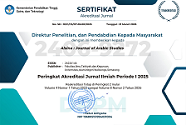Domestication and Foreignization Strategies in the Translation of Humorous Hadiths: An Inquiry into Translation Ideology
DOI:
https://doi.org/10.21580/alsina.7.1.26831Keywords:
Domestication, foreignization, humorous hadith, translation ideology, translation strategiesAbstract
The difficulty of translating humor that is rich in cultural and religious values poses a dilemma between preserving the authenticity of the source text or adapting it to the culture of the target audience. This challenge becomes even more significant in the translation of the Prophet's humorous hadiths, which contain messages of Islamic preaching and ethics. To address this issue, a qualitative approach was employed, involving content analysis of the humorous hadiths in the book Everything Has Its Time by Sheikh Mahmud Al-Mishri, translated by Ustadz Abdul Somad. Data analysis was conducted by identifying cultural words, classifying translation strategies according to Peter Newmark, and interpreting ideological tendencies based on Lawrence Venuti's domestication and foreignization theory. The results of the study indicate that domestication strategies, particularly descriptive equivalent, through-translation, and paraphrase, were used most frequently, while other strategies such as componential analysis, recognized translation, modulation, and shifts appeared less often. The conclusion suggests that domestication strategies contribute to achieving a balance between meaning accuracy and cultural acceptance, thereby maintaining both comprehensibility and religious values. Translators of religious humorous texts are therefore encouraged to uphold this balance so that the message of Islamic preaching remains intact and communicative.
Downloads
References
Al-Rikaby, Ali Badeen Mohammed et al. “Domestication and Foreignization Strategies in Two Arabic Translations of Marlowe’s Doctor Faustus: Culture-Bound Terms and Proper Names.” Pertanika Journal of Social Sciences and Humanities 26, no. 2 (2018): 1019–34. http://www.pertanika.upm.edu.my/pjssh/browse/regular-issue?article=JSSH-2618-2017.
Al-Saidi, A. Ali H., and Sabariah Md Rashid. “The Illusion of Untranslatability: A Theoretical Perspective with Reference to the Translation of Culture-Bound Euphemistic Expressions in the Qur’an.” International Journal of Applied Linguistics and English Literature 5, no. 3 (2016): 81–90. https://doi.org/10.7575/aiac.ijalel.v.5n.3p.81.
Al-Sawaeer, Sara et al. “Humor in the Arabic Comedy Show, N2O.” Cogent Arts and Humanities 9, no. 1 (2022): 1–16. https://doi.org/10.1080/23311983.2022.2082019.
Al-Yasin, Noor. “Translation Procedures of Cultural-Bound Expressions in the Egyptian Vernacular Dubbed Versions of Three Disney Animated Movies.” Open Cultural Studies 6, no. 1 (2022): 294–306. https://doi.org/10.1515/culture-2022-0162.
Alaa, Ahmed M., and Islam Al Sawi. “The Analysis and Quality Assessment of Translation Strategies in Subtitling Culturally Specific References: Feathers.” Heliyon 9, no. 8 (2023): e19095. https://doi.org/10.1016/j.heliyon.2023.e19095.
Alifiansyah, Roby Fathan et al. “Hubungan Kata Dan Makna Dalam Bahasa Indonesia Dan Bahasa Arab: Kajian Semantik.” Alsina : Journal of Arabic Studies 5, no. 1 (2023): 73–92. https://doi.org/10.21580/alsina.5.1.16868.
Alkaraki, Sulaiman Mohammad Shlash et al. “Arabic Verbal Humor: An Exploration of Non-Observance of Cooperative Principle on Social Media.” Journal of Language Teaching and Research 14, no. 6 (2023): 1680–88. https://doi.org/10.17507/jltr.1406.27.
Alnusairat, Suhib A., and Paramaswari Jaganathan. “Humour in Translation From English Into Arabic: Subtitles of the Comedy Sitcom Friends.” Theory and Practice in Language Studies 12, no. 7 (2022): 1447–56. https://doi.org/10.17507/tpls.1207.27.
Amenador, Kate Benedicta, and Zhiwei Wang. “The Translation of Culture-Specific Items (CSIs) in Chinese-English Food Menu Corpus: A Study of Strategies and Factors.” Sage Open 12, no. 2 (2022). https://doi.org/10.1177/21582440221096649.
An, Gang. “Domestication and Foreignisation in Translation Studies: A Bibliometric Analysis of WoS Core Journal Articles.” Journal of Intercultural Communication 24, no. 4 (2024): 13–22. https://doi.org/10.36923/jicc.v24i4.933.
Farghal, Mohammed, and Ahmad S. Haider. “A Cogno-Prosodic Approach to Translating Arabic Poetry into English: Human vs. Machine.” 3L: Language, Linguistics, Literature 31, no. 1 (2025): 255–71. https://doi.org/10.17576/3L-2025-3101-17.
Farisi, Mohamad Al. “The Impact of Using Foreignization and Domestication on the Translation Accuracy of the Quranic Metaphor (Kinayah) Verses.” Humanities and Management Sciences - Scientific Journal of King Faisal University 21, no. 1 (2020). https://doi.org/10.37575/h/rel/1966.
Hilmi, Mustofa. “Humor Dalam Pesan Dakwah.” Jurnal Ilmu Dakwah 38, no. 1 (2019): 87. https://doi.org/10.21580/jid.v38.1.3972.
Islami, Toat Abdaul et al. “Humor Techniques in a Collection of Anecdotal Texts from Dari Canda Nabi Dan Sufi Sampai Kelucuan Kita by Mustofa Bisri.” KEMBARA Journal of Scientific Language Literature and Teaching 10, no. 1 (2024): 132–46. https://doi.org/10.22219/kembara.v10i1.27957.
Khalaf, Abed Shahouth, and Sabariah Md Rashid. “Domestication or Foreignization: Strategies Adopted in the Amateur Subtitling of Swearwords in American Crime Drama Movies into Arabic.” Dirasat: Human and Social Sciences 47, no. 2 (2020): 498–514. https://doi.org/10.35516/0103-047-985-034.
Lesmana, Maman. “Humor and Language Errors in Arabic-English Informative Discourse.” International Journal of Society, Culture and Language 9, no. 1 (2021): 58–68. https://www.ijscl.com/article_242575.html.
Marwan, Iwan. “Rasa Humor Dalam Perspektif Agama.” Buletin Al-Turas 19, no. 1 (2013): 267–78. https://doi.org/10.15408/bat.v19i2.3720.
Metwally, Amal Abdelsattar. “Foreignising versus Domesticating Translations of Arabic Colour-Related Expressions.” Journal of Language Teaching and Research 10, no. 2 (2019): 383–90. https://doi.org/10.17507/jltr.1002.21.
Mohammad, Saba J., and Hala Kh Najim. “Exploring the Strategies of Domestication and Foreignization in the Translation of Socio-Cultural Aspects in Mosteghanemi’s Novel Chaos of the Senses.” Theory and Practice in Language Studies 14, no. 12 (2024): 3845–50. https://doi.org/10.17507/tpls.1412.19.
Newmark, Peter. A Textbook of Translation. New York: Prentice Hall, 1988.
Rahmadi, Agustian. “Kesalahan Penerjemahan Google Translate Pada Hadis Arbain Berdasarkan Konteks Keagamaan (Kajian Akar Kata Dan Morfologi Turunan).” Alsina : Journal of Arabic Studies 4, no. 1 (2022): 69–94. https://doi.org/10.21580/alsina.4.1.8332.
Robati, Fatemeh Zahra Nazari. “Comparative Analysis of Strategies Applied in Persian and English Translations of Quranic-Arabic Culture Bound Term ‘Jilbab’ (33:59).” International Journal of Applied Linguistics and English Literature 5, no. 2 (2016): 64–75. https://doi.org/10.7575/aiac.ijalel.v.5n.2p.64.
Saad, Charleine. “Between Domestication and Foreignization: A Study of How an Italian Film Remake Got Lost in Translation in the Arab World.” Languages 8, no. 4 (2023). https://doi.org/10.3390/languages8040273.
Tsani, Muhammad Jaohar et al. “Cooperative Principle in Verbal Humour: Analysis of Arabic Podcast Short Films.” Arabi : Journal of Arabic Studies 9, no. 1 (2024): 1–12. https://doi.org/10.24865/ajas.v9i1.783.
Venuti, Lawrence. The Translator’s Invisibility : A History of Translation. 2nd ed. London: Routledge, 2008. https://doi.org/10.4324/9780203553190.
Downloads
Published
How to Cite
Issue
Section
License

This work is licensed under a Creative Commons Attribution-NonCommercial-ShareAlike 4.0 International License.
Copyright
The copyright of the received article shall be assigned to the publisher of the journal. The intended copyright includes the right to publish the article in various forms (including reprints). The journal maintains the publishing rights to published articles. Authors are allowed to use their articles for any legal purposes deemed necessary without written permission from the journal, but with an acknowledgment to this journal of initial publication.
Licensing
In order for Alsina: Journal of Arabic Studies to publish and distribute research articles, the editors need publishing rights (transferred from author to publisher). This agreement relates to the transfer/publishing copyright license to Alsina: Journal of Arabic Studies but the authors still have significant rights to use and share their published articles.
Alsina: Journal of Arabic Studies supports the need for writers to share, disseminate and maximize the impact of their research and their rights on any database. As a journal article writer, you have the right to various uses of your articles, including that by the institution or company where you work. Copyright can be used without the need for special permission. Authors who publish articles in the Alsina: Journal of Arabic Studies have broad rights to use their work for teaching and scientific purposes without requesting permission, including:
- Use by the author for lectures, presentations, or conferences, with distribution of copies to participants;
- Distribution to colleagues for research use;
- Use in compilations of the author's subsequent work;
- inclusion in a thesis or dissertation;
- Reuse of sections or excerpts from articles in other works (with full acknowledgment of the final article);
- Preparation of derivative works (other than commercial purposes) (with full acknowledgment of the final article);
- Voluntary posting on open websites operated by authors’ or writers' agencies for scientific purposes
When submitting a manuscript, authors do so on the understanding that if accepted for publication, the copyright for publishing (publishing right) of the article shall be assigned/transferred to Alsina: Journal of Arabic Studies.
Authors whose articles are accepted for publication will receive confirmation via email and sent a Copyright Transfer Agreement.

 Accreditation
Accreditation 
 In Collaboration with
In Collaboration with 

 Visitors
Visitors  Article Template
Article Template





